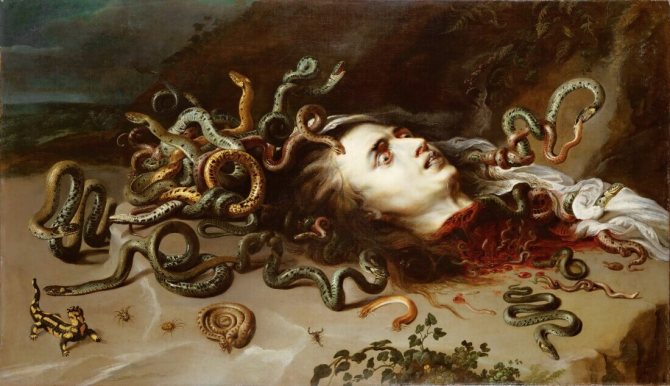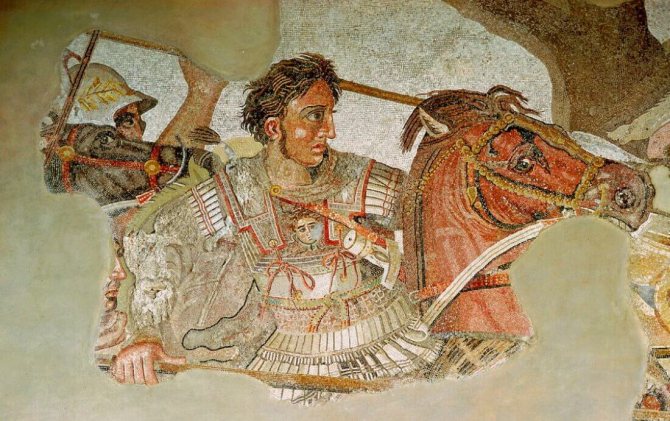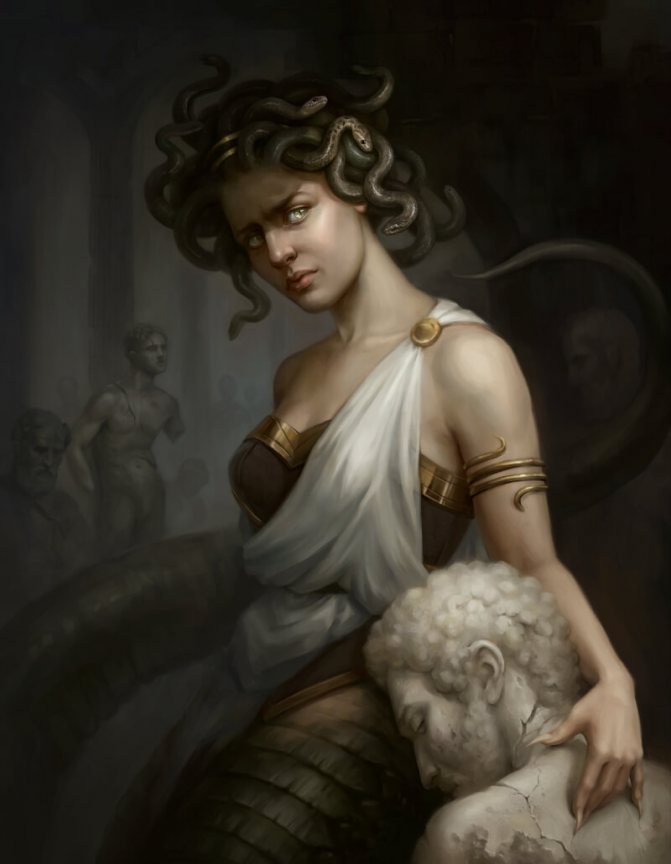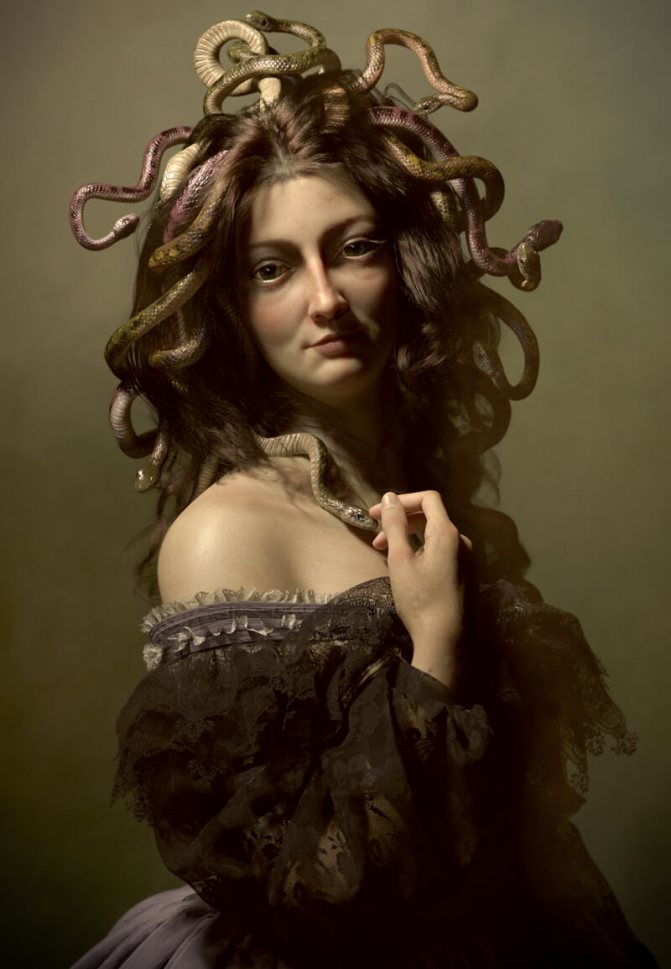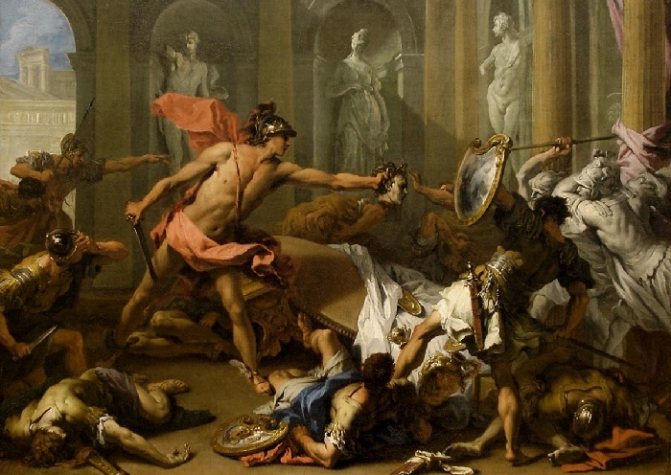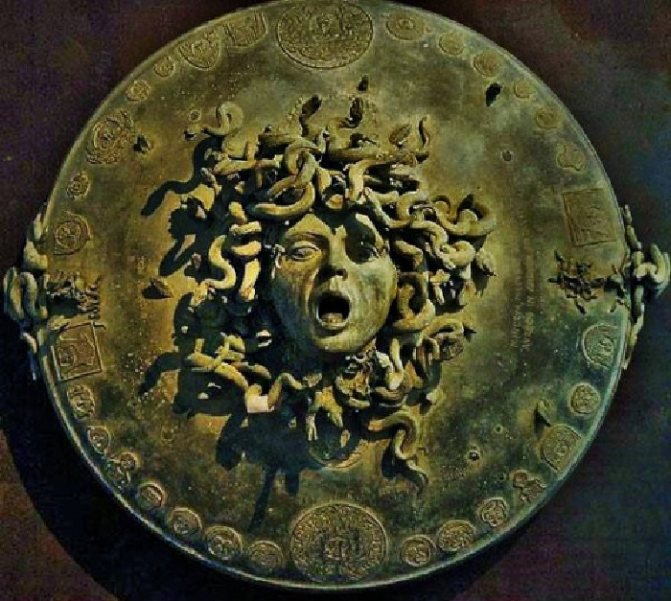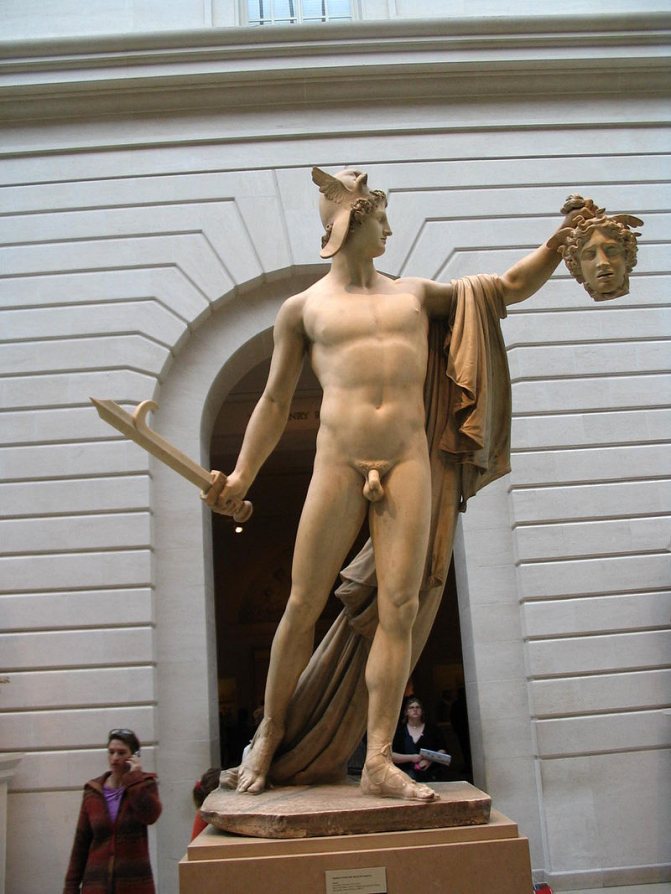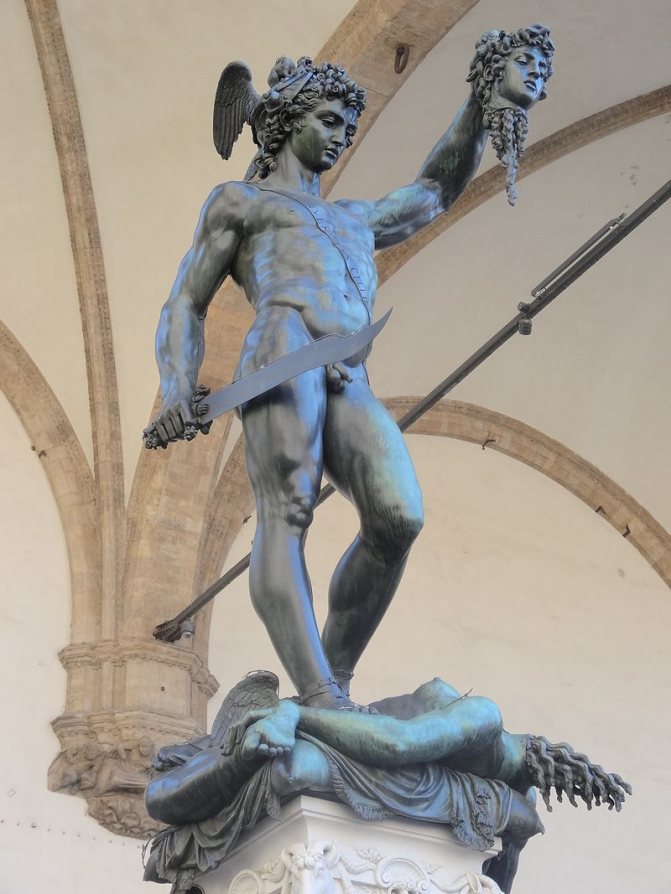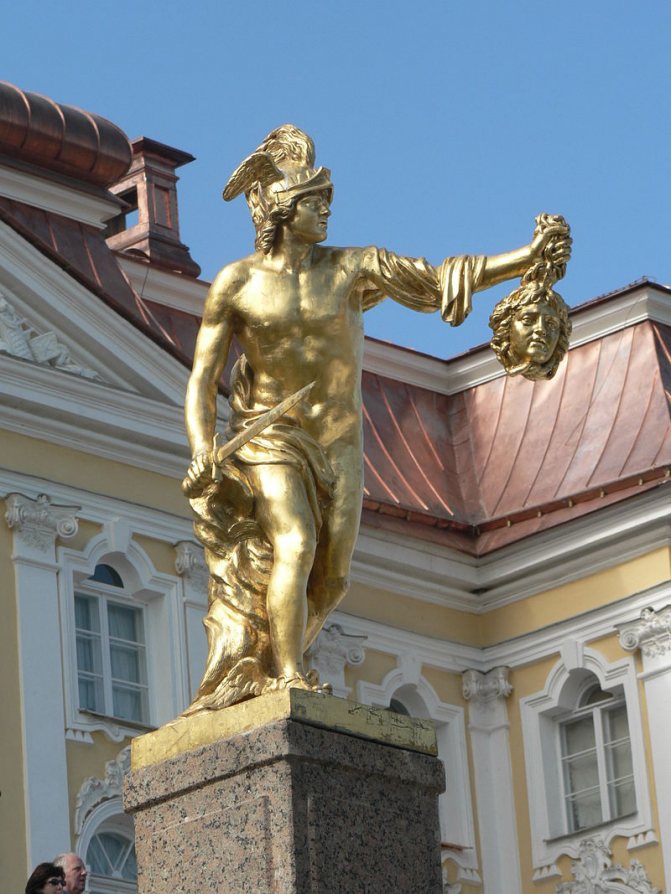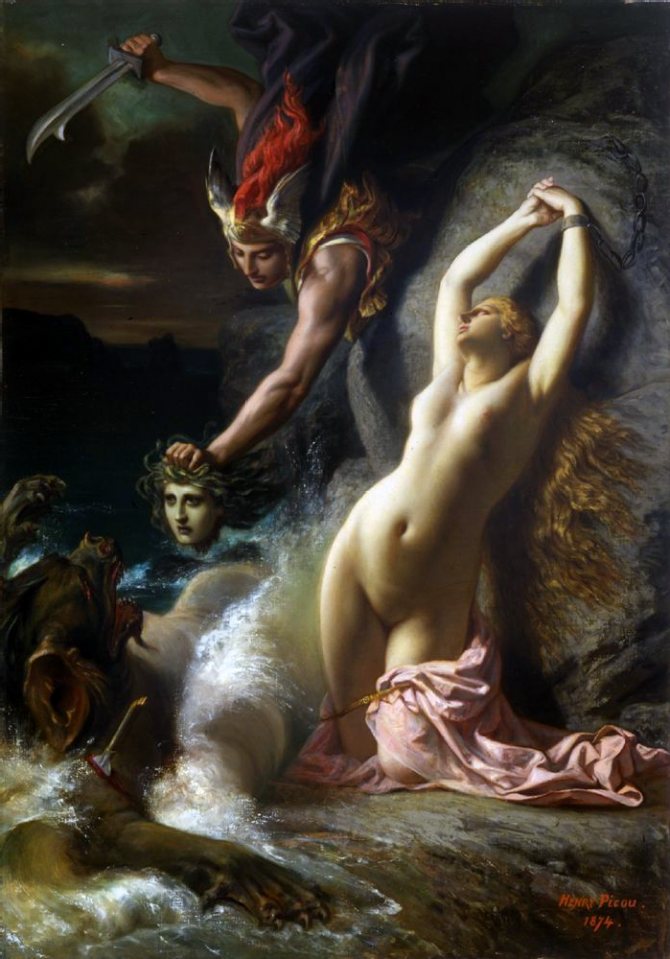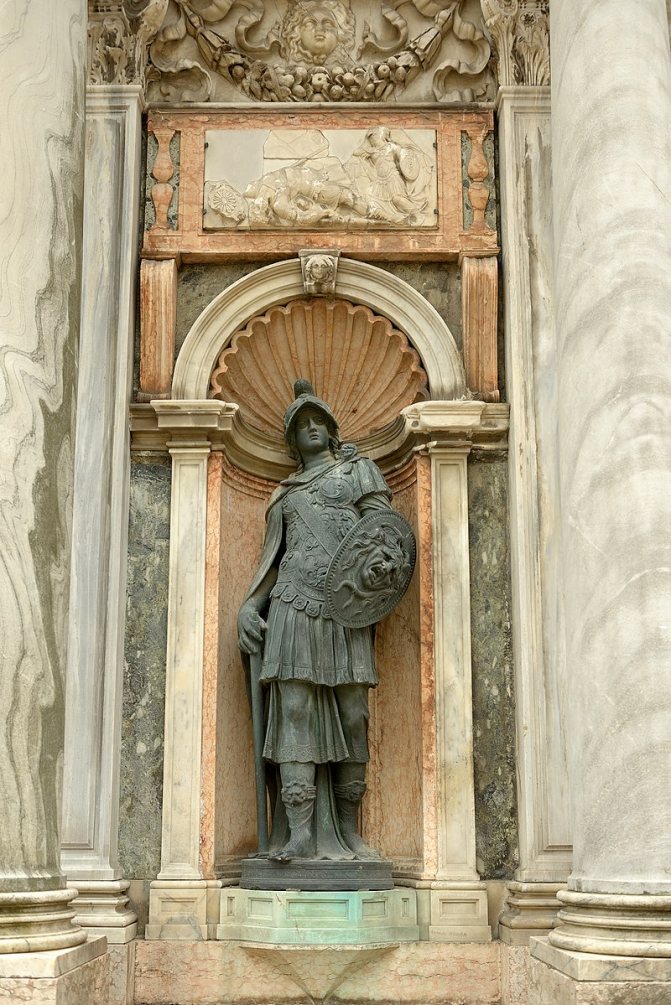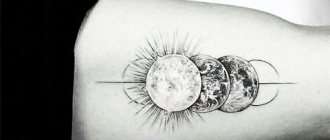Medusa Gorgon is a famous creature of ancient Greek lore.
We are used to imagine Medusa Gorgon as a terrible monster. This is how most of the known ancient Greek legends tell about her, but for some reason the myths of her origin and transformation have been relegated to the background. Can you imagine that once Medusa was one of the most beautiful girls in Greece? And that's exactly what she was.
As is often the case, the gods intervened in her fate, against which a mortal man is unable to resist. What does the life story of this strange heroine evoke: pity or contempt? Because of what Medusa Gorgon took her horrible form?
Medusa's Birth and Childhood
In those distant times, when the gods did not yet rule the world, the earth was ruled by titans. The last of the titans were Phorkias and Keto, who had six children. Three of them were originally born in the guise of elders. Subsequently they became Forcids. However, the other three were beautiful girls of simply unearthly beauty. They received the nickname of gorgon.
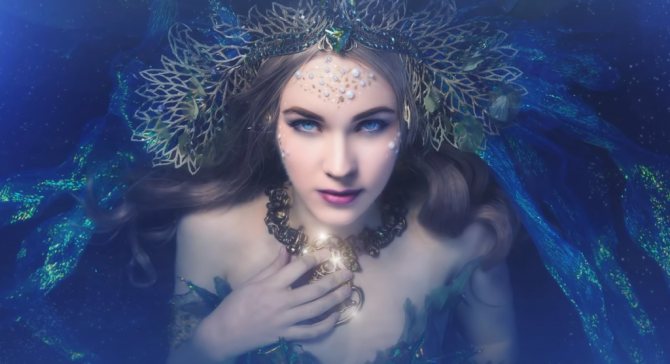
It is noteworthy that all the children of the titans were immortal. All except their youngest daughter, Medusa Gorgon. Nevertheless, it was she who was the most beautiful of all. She was an incredible beauty with long golden curls. Not surprisingly, Medusa Gorgon broke more than one man's heart, and was the envy of even the beautiful immortal goddesses.
Medusa Gorgon's origins
Beauty, for Medusa Gorgon, was both a gift and a curse. She attracted the eyes of men with her appearance, and even the gods were no exception. So, the young beauty became interested in Poseidon himself, but the proud Medusa more than once rejected the onslaught of the god of the seas and oceans. For this Poseidon began to pursue the poor girl everywhere.
In an attempt to escape, Medusa decided to hide in the temple of Athena. The girl hoped that in this sacred place Poseidon would leave her alone. But Poseidon did not think that he would calm down, and even the sacredness of the temple was not an obstacle. But the cunning Poseidon turned bird, flew into the temple of Athena, and raped Medusa there, against her will, right on Athena's altar.
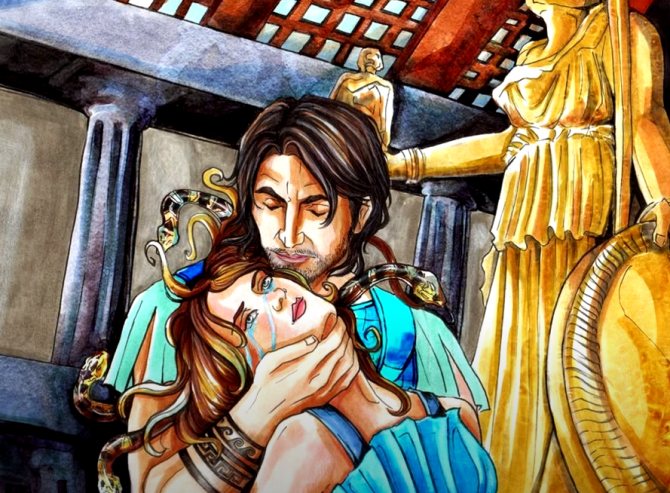

The gods, and Athena in particular, were angry with the poor girl for the sacrilege she had committed. This is where the main injustice in Medusa's life is revealed. The virginal Athena, who was secretly jealous of the girl's beauty, instead of helping her and solving her problem justly, was more enraged than anyone else.
For her transgression, Medusa Gorgon was transformed into a terrible monster. Her beautiful hair was replaced by snakes, her body was covered with scales, and her hands became huge, with steel claws on the ends. Her face was changed beyond recognition and now adorned with fangs. Most importantly, the girl also received a terrible curse. From now on, any living thing that looked into her eyes would turn to stone.
Anton
Ask a question
Question for an Expert
Why did Athena hate Medusa the Gorgon so much?
Most likely the reason lies in the usual envy. A similar situation happened with Arachne. After all, according to one of the legends, it was Athena who turned her into a spider.
Legend has it that Medusa's sisters, Spheno and Euryale, stood up to protect the innocent sister. After Poseidon dishonored her, they volunteered to become monsters like their mortal sister in order to support her. According to another version, the enraged Athena forcibly transformed them as well.
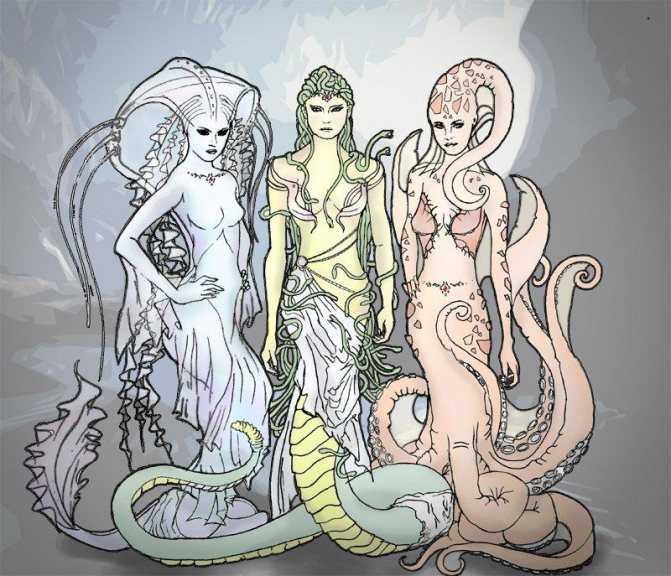

Biography [ ]
Poseidon's Mistress [ ]
Gorgon Medusa was in love with Poseidon, god of the sea. She was waiting for him in the temple of the goddess Athena. The angry goddess turned Medusa and her sisters (other versions say only Medusa, but the sisters themselves later asked to share Medusa's punishment) into disgusting monsters. The sisters took up residence in a cave on the coast of the Ocean. Every passerby turned to stone when he saw the gorgon. And not only people, even animals were turned to stone.
Death of Medusa [ ]
Perseus set out to save men and beasts (or rather he received this task from Polydectus, who was in love with his mother) from Medusa Gorgon, taking the winged sandals of Hermes, the invisible helmet of Hades and the mirror shield of Athena. Perseus flew up to the sleeping Medusa and cut off her head. Pegasus and Chrysaor emerged from Gorgon's body.
Medusa's head and blood [ ]
Perseus flew home. The drops of blood fell into the sea and turned into coral, and those that fell into the Libyan Desert turned into poisonous snakes (as well as basilisks, aspids, amphisbens, and ammodites). On the way he met Atlas and asked for shelter. Atlas refused and Perseus showed him the head of the Gorgon. Atlas turned into stone. In the same way Perseus showed the head to the sea monster and saved Andromeda. Perseus then avenged his rival king, Polydectus, by showing him the deadly head as well.
Voluntary Exile and First Victims
The reincarnated sisters realized how sad their present fate had become. No one could look at them now, for all who looked into their sisters' eyes were immediately reduced to stone. Sensing that they had no place among men or among the gods, the Gorgon sisters went into self-imposed exile on a distant island where they could do no harm to men.
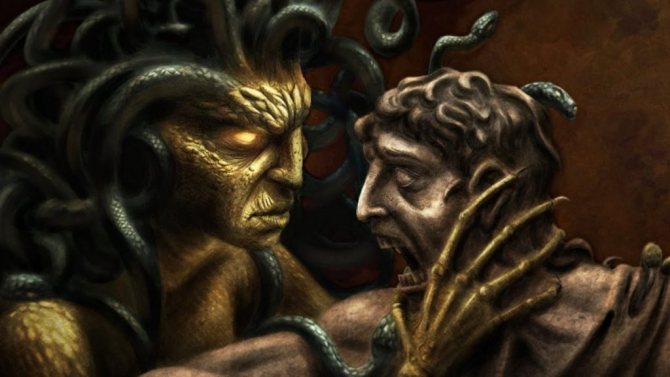

However, their altered appearance did the trick. As time passed, people began to regard the sisters not as unhappy victims of the gods' machinations, but as horrible creatures who do nothing but harm. Thus, the unhappy sisters really turned into what they were thought to be. Namely, horrible monsters that destroy all life. And the most bloodthirsty of the sisters was the youngest Medusa, who was treated so unfairly.
Perseus
Centuries have passed, but Athena's resentment has not gone away. Not long before, however, the treacherous Zeus infiltrated Danaë's dungeon. She was there because of her father who had been told that he would be killed by his own grandson. So he kept his daughter under lock and key. But the cunning Zeus, who wanted to enjoy his next mistress, was inventive. He turned into a golden rain and trickled through the walls of the prison.
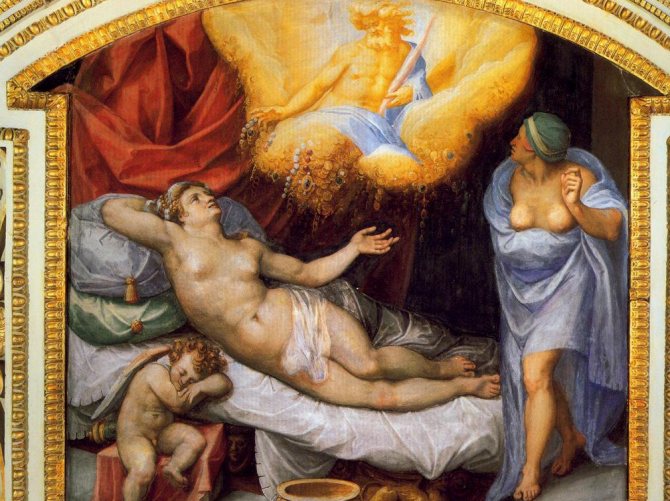

Recommended on the subject
Aphrodite Zeus Artemis
Danaë became pregnant, but her father, King Acrisius of Argos, did not believe the story about the conception of a child by Zeus. Moreover, he was very afraid of the prophecy, so he chained his daughter and grandson in a box, which he threw into the sea. But the box was washed up on Seriphos Island. Legend has it that a fisherman fished him out and took him to King Polydectes, who was the ruler of that island. The king sent the boy to the temple of Athena, and he himself began to take care of Danaë.
But no matter how he tried, Danaë always rejected his advances. He could not take her by force - he was afraid of the vengeance of Perseus, who, incidentally, was growing by leaps and bounds and became more and more virile every day. Then the cunning Polydectus decided to get rid of the protector of Danaë by cunning. He ordered Perseus to bring the head of the terrible Medusa Gorgon, the rumour of which, by that time, had reached this land.
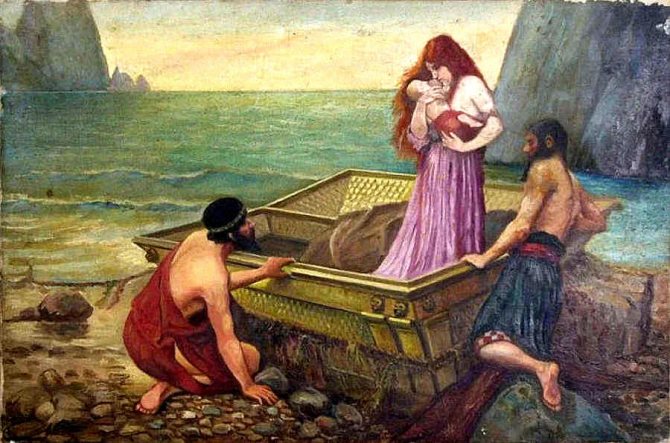

It should be said that Perseus, who had been brought up in the temple of Athena, did not resist too much. And the thirst for revenge had not left the goddess, even after all these years. And the other gods were only for Perseus to destroy the bloodthirsty sisters. That is why they helped him, some with wise advice, some with artifacts, and some with a simple blessing.
The Defeated Monster
To the fate of Medusa we return with the myth of Perseus, which is what fixed the cursed woman's monstrous appearance. At that point, many centuries had passed since Medusa's conversion, but Athena was still unable to curb her anger. When the prince Perseus is given the task of bringing Medusa Gorgon's head, the goddess of war actively assists him, as well as attracting other gods.
Athena's gift to the hero was a shining shield that resembled a mirror, as well as a magic sickle with which Perseus could cut off the monster's head. The goddess told him about the murderous power of Medusa Gorgon's eyes, and on the way Perseus received winged sandals, a magic hat, and a bag for his trophy from the other deities.
Medusa Gorgon's Fate
Over time, people have forgotten that the Gorgon sisters were once pure and innocent. Around the Earth spread the rumor of terrible creatures that live on a remote island, which either destroy the travelers, tearing them to pieces, or turn them into stone with their gaze. Indeed, many centuries have passed and the Gorgons have already forgotten how they became monsters. Resentment and lust for revenge clouded their minds, and they began to take revenge on everyone around them.
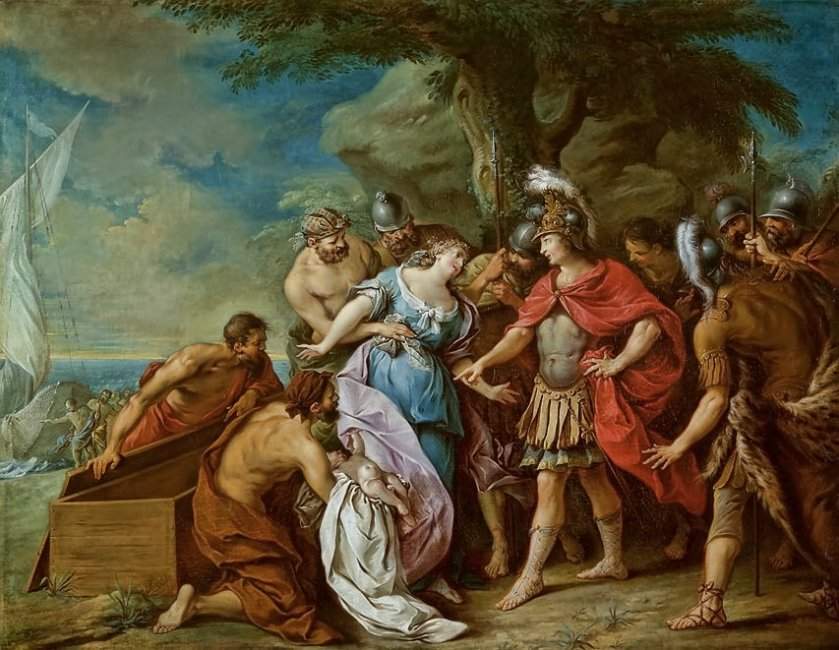

But centuries passed, and one day, several important events merged together, which subsequently affected the fate of the Gorgon sisters, and Medusa in particular.
The events consisted of Polydectes, who had developed a passion for Danaë and decided to get rid of her protector, the son of Perseus, with a cunning, cunning and difficult task in order to take Danaë by force without consequences, afterwards. It is also the grown-up Perseus, the young and strong son of Zeus, who at all costs needed to prove himself both among men and among the gods. And, of course, there is Athena's long-standing hatred and envy, which has not subsided even after all this time.
The difficulty of Perseus' task was not even so much in fighting the terrible creatures as in determining their location. After all, the Gorgons had traveled centuries ago to a distant and uninhabited island, whose location was known only to the Gorgon sisters, the Grays, who from birth were horrible old women who possessed one eye for three.
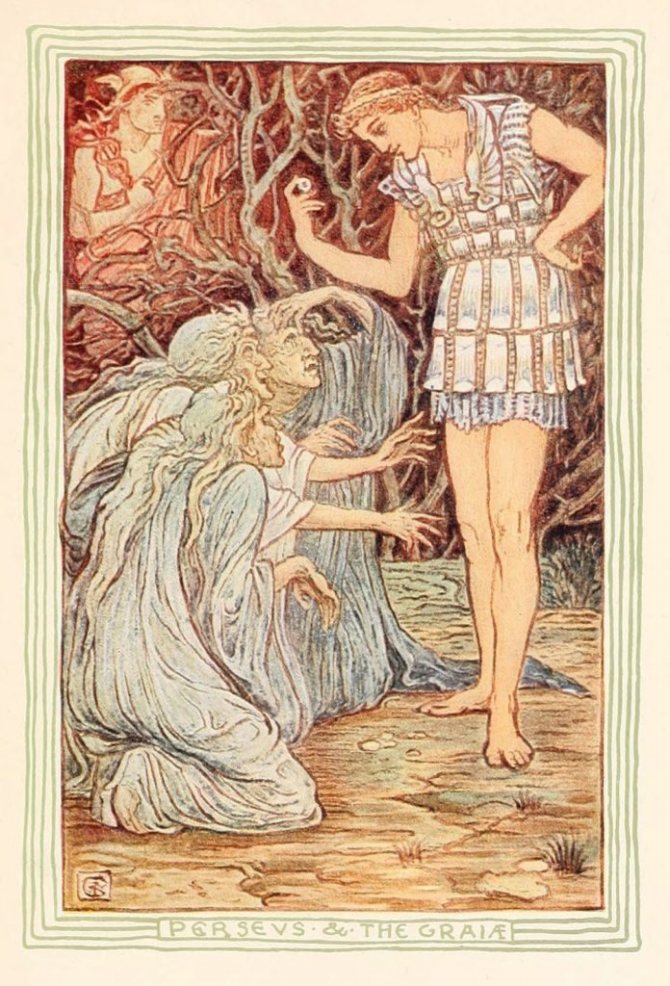

To accomplish this task, Perseus went to the Gaia and stole their only eye. The old women, afraid of going blind forever, did not hesitate to give the young hero the location of the Gorgon sisters. In addition, Perseus traded them for a magic bag that could contain the Gorgon's power, an invisible hat belonging to Hades, the god of the underworld, and winged sandals.
According to one legend, the winged sandals were given to Perseus by Hermes, who taught the hero how to behave with the Graces.
Athena, the goddess of wiches and strategy, taught Perseus how to fight the Gorgon. For this she gave him a shield polished to a shine, and Hermes gave the young hero a sickle-shaped adamantine blade capable of cutting off even the head of such a monster as Medusa Gorgon.
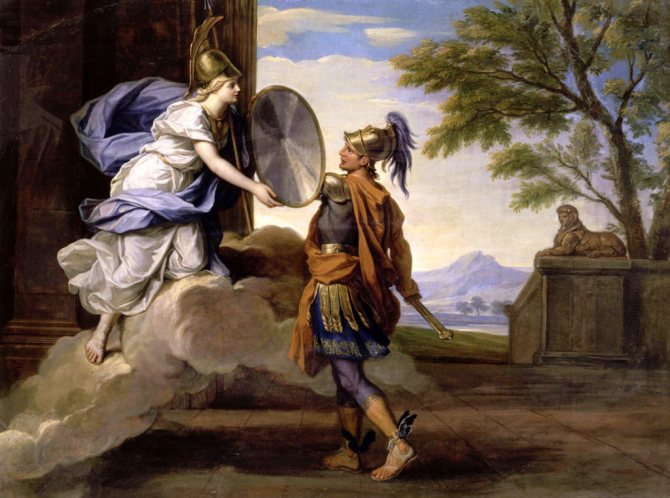

With such training and such equipment, even a baby could defeat Medusa Gorgon. Never mind the strong and brave son of the supreme god. Perseus did not invent a bicycle, but strictly followed the instructions that Athena gave him. He reached the island where the Gorgon sisters were on his winged sandals. With his sandals he silently flew up to the sleeping Medusa, with the invisible cap of Hades on, and cut off the sleeping Medusa's head, then placed it in a magic bag.
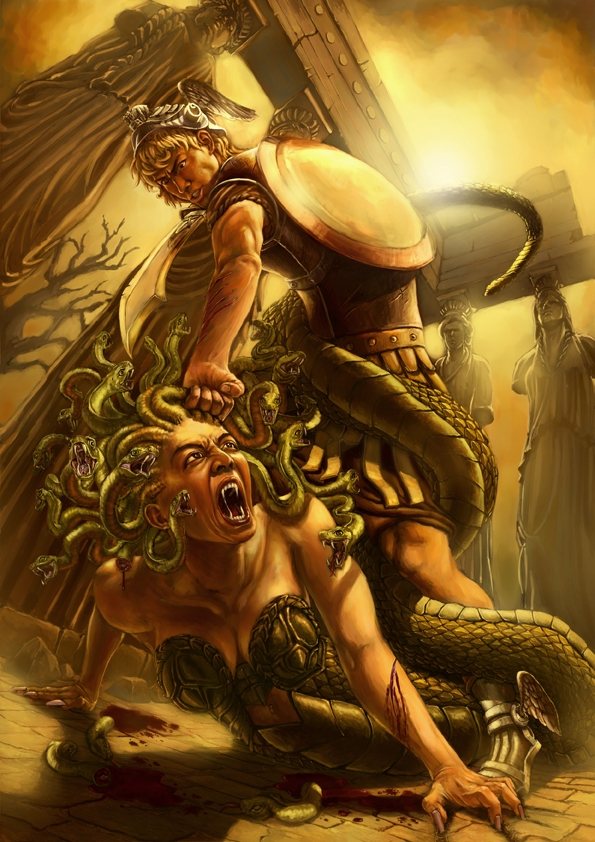

Medusa's head did not lose its magic power to turn everything into stone, which Perseus used several times more during his return journey, but we will tell you about that directly in the article about the young hero. The only thing we will mention is that the head of Medusa was attached to the shield of Athena, the very shield into which Perseus was looking, in order that he should not accidentally meet Medusa. The shield was called the Aegis.
From Medusa's spilled blood came the handsome giant Chrysaurus and the famous Pegasus, who would later be tamed by Bellerophonte. By the way, according to legend, the blood flowing from the left side of Medusa's body carried death, while the blood flowing from the right side of her body gave life. Athena collected it and later gave it to Asclepius, the great healer.
Screenings of
Famous filmmakers also rave about the myths of ancient Greece, which have migrated from the writings of the writers to the big screens. Consider popular cinematic works featuring Medusa Gorgon.
Director Chris Columbus, whose track record includes films about Harry Potter, brought the book writer Rick Riordan to the screens in "Percy Jackson and the Lightning Snatcher" (2010). The story is about the demigod Percy, son of Poseidon, who lives in modern America. When the boy discovers his divine origins, he faces a series of troubles.


Uma Thurman as Medusa
The antagonist Medusa Gorgon was played by Quentin Tarantino's favorite, Uma Thurman. It is noteworthy that actress Serinda Swan was tried for this role, but she was given the role of Aphrodite. In addition, the cast included Logan Lerman, Brandon T. Jackson, Alexandra Daddario, Jake Abell and Sean Bean.
That same year, director Louis Leterrier released "Battle of the Titans," a film about Perseus' dangerous mission - the hero must defeat Hades. The cast of this film includes Sam Worthington, Mads Mikkelsen, Gemma Arterton and Rafe Fiennes, and the role of the half-woman half-moon was played by Natalia Vodianova. It is worth saying that in this picture there are discrepancies with the true myths, for example, according to the plot the young hero travels on a winged Pegasus, not with the help of sandals.
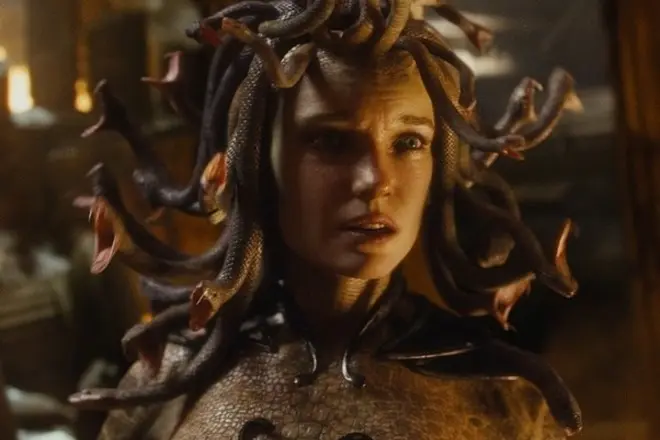

Natalia Vodianova in the image of Medusa
Also Gorgon appeared in the TV series "Doctor Who" and in the fantasy "Voyage of the Unicorn", where the dangerous woman was played by actress Keira Clavell.
Further story of Medusa
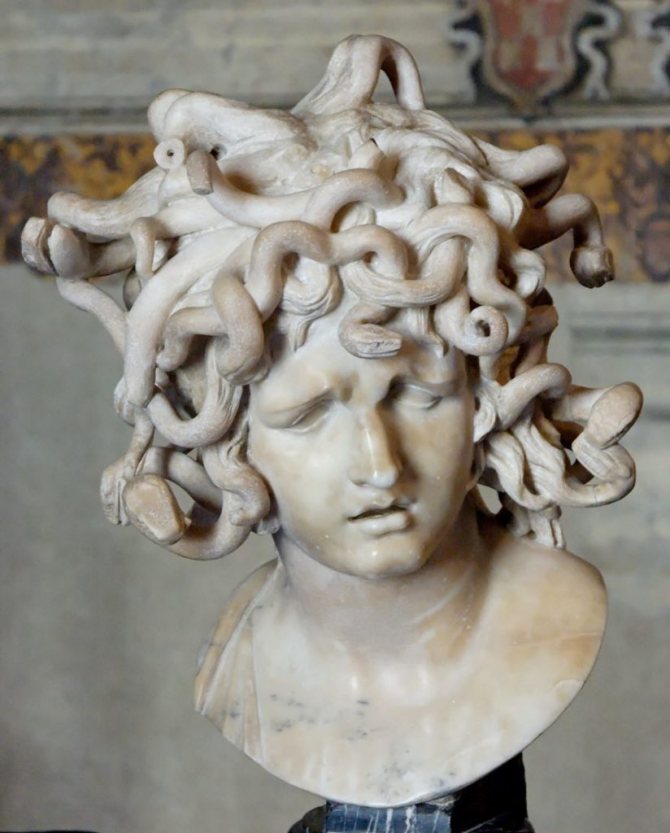

The sad fate of Medusa Gorgon - a great beauty, turned into a terrible creature by the will of the gods. However, history is an interesting thing, and later it put everything in its place. Medusa ceased to be perceived as a terrible monster that exterminates humanity. Many warriors, and just ordinary citizens, carried with them talismans depicting the head of Medusa Gorgon. It was believed that such talismans are also amulets.
Question for the expert
Why did Athena later wear the head of Medusa the Gorgon on her shield?
One of the reasons was a symbol of strength and power. So Athena showed what she could do to all the unwanted. The second reason was that the head of Medusa was a really strong weapon, which the goddess of wise war used more than once.
Subsequently, Medusa has resurfaced more than once in the history of various countries of the world. It is said that Alexander the Great himself found the head of Medusa - his victories were so brilliant and mind-boggling that many believed that a simple man simply could not do it. Also various sources say that on the armor of the great general was depicted the face of Medusa Gorgon.
The image of the head of Medusa was popular in the culture of the ancient world. Often the image of the head of Medusa minted on coins, portrayed on dishes and walls, found on amulets. It was believed that the Gorgon guards its owners from evil sorcerous forces.
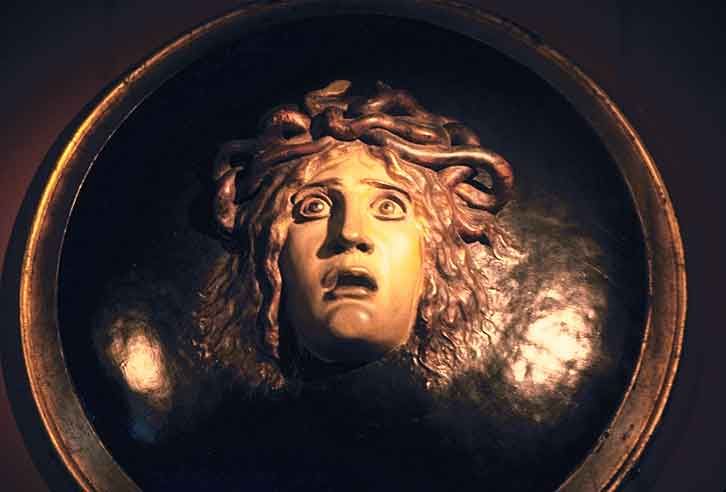

As you can see, the fate of the Gorgon Medusa is rather more sad than horrible. She does not at all deserve such importance in history, which is attributed to her in modern stories, movies and cartoons. After all, Medusa did not become a monster of her own free will. Moreover - it became them completely undeserved. Today, Medusa is depicted on the flag of Sicily. According to legend, it was there that she met her death. An amazing beauty who became the most terrible of monsters in the history of mankind.
Technique
The image looks favorably in black and white technique. Gorgon is beaten in the styles of chicano, graphics, sketch style, graphics. The picture looks original in the color scheme new skool, watercolor.
For connoisseurs of realism Medusa is an invaluable source of inspiration. The aggressive nature of the symbol will well reflect the thrash polka. For those who prefer a classic drawing to tattoo wearers, the etching style is ideal.
Where to stuff it
Stamped on the forearm head of the Gorgon can be the beginning for the creation of a sleeve in the theme of Greek myths. The drawing looks favorably on the chest, back, and shoulder blade. Girls often cover the shoulder, waist line, hip with the image of the mythical heroine. For men, it is a priority to use the torso and calf.
Tips for sketches
The sketch will look original, if you decide on the meaning of the message. The master will be able to find a pose and facial expression that best reflects your originality.
We recommend reading: Diamond, the meaning of the tattoo
The tattoo is an allegory on the concepts of beauty and monstrous power. This is the main leitmotif of this image. The Greek heroine will become a decoration of your skin and a protector from negativity, if you creatively approach the treatment of the image of the character.

